The lapel also looks wider itself because it is so short and square.
It measures 3¾ inches across, which is wide, but the same as both Caraceni and Anderson & Sheppard.
The difference is that the roll only really starts around the top button (see image above), making it shorter. And it’s a straight lapel, making it thinner than anything English (which will usually curve inwards).
There’s also a very subtle point at work here. The cutter I work with to analyse these suits pointed out that the notch in the lapel is almost a perfect right angle.
This is a small point, but I’m sure it adds to the impression that the shoulder is wide and square (despite actually only having thin padding).
That tailor (who would rather remain anonymous) was also very enthusiastic about the finishing.
Everything is just very precise. That’s not an easy thing to communicate about a jacket. It’s certainly harder to talk about than Parisian top stitching or buttonholes, for example.
But it’s often the kind of thing a tailor will most admire: not more work, but better-executed work. Jettings on pockets that are precise and identical; finishing around internal pockets that is sharp and exact.
That extends, of course, to the making aspect Liverano is best known for: the single dart in the waist of the jacket, which curves forwards into the hip pocket and stops there, leaving everything below clean and seamless.
How easy or useful such a construction is depends on the customer’s shape. But it’s nearly always harder than using two seams, as every other jacket we’ve featured in this series has.
It’s also something a lot of tailors can do. Panico, for instance, did it on his suit for me just because he thought it was ‘more English’, even though he wouldn’t normally.
Tailors just generally don’t because it’s harder – and having that lower part of the jacket clean is not seen as a priority.
I entirely understand customers who think it’s beautiful, and those that think it’s irrelevant.
Elsewhere on the jacket, there is a little drape in the chest, but not much. More than other Italians or French. The armhole is particularly high.
The sleeve and cuff are pretty standard: not as slim as the French or most Neapolitans.
The pockets are interesting. The welt of the outbreast pocket is deeper than most, at 1¼ inches, while the flaps on the hip pockets are small, barely 2 inches. It’s hard not to see one more thing that adds weight to the top half of the jacket.
On the finishing, it should also be noted that the seams are top stitched all around the jacket, and the edges swelled by stitching that is a ¼ inch from the edge.
Both give an impression of thickness to the lines of jacket, and casualness that would be more relevant were the cloth not so overpowering.
As ever, the articles in this series are not intended to discuss fit, or the images intended to show it accurately.
The chest is a good, clean fit, for example, despite a couple of stray wrinkles in the front-on shots. The pitch is also good, despite what the sleeves might suggest above.
One thing that is true, however, is that those high armholes are catching me, and could have been lower.
The trousers shown with the jacket were not made by Liverano, but by Luxire in Crispaire 337051 (9/10 ounce).
The shirt is made by Luca Avitabile in Permanent Style Oxford fabric, and the spotted silk handkerchief is from Anderson & Sheppard.
The loafers are the Belgravia model from Edward Green, with EG’s distinctive burnishing on the toes and heels. The trousers are being held up to better show the loafers off; they’re not actually that short.
Style breakdown:
- Shoulder width: 6½ inches
- Shoulder padding: Thin
- Sleevehead: Slight roping
- Sleeve: Moderate, regular cuff
- Lapel: 3¾ inches
- Gorge height: 4¼ inches
- Drape: Moderate
- Outbreast pocket height: 10 inches
- Buttoning point: 18 inches
- Waist suppression: Slim
- Quarters: Open, cut away from waist button
- Length: 31¼ inches
- Back seam: Suppressed
- Vent height: 9¾ inches
- Trouser circumference at knee: 19¾ inches (not made by Liverano)
- Trouser circumference at cuff: 15¼ inches
For more articles in this series, see menu at the top right (or below on a mobile device). Also available here.
Photography: Jamie Ferguson


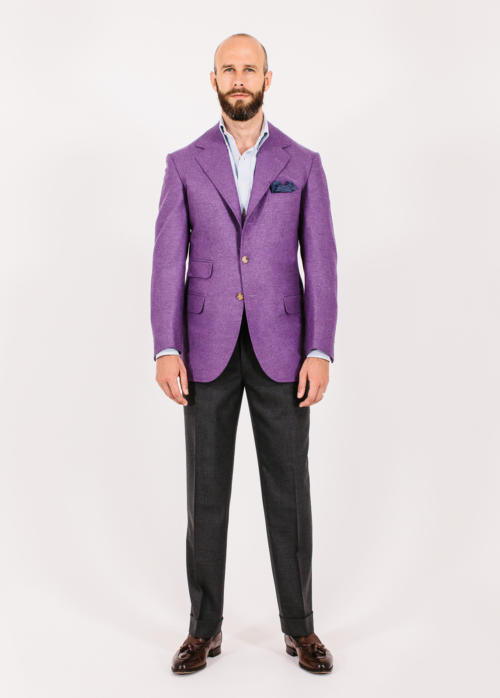
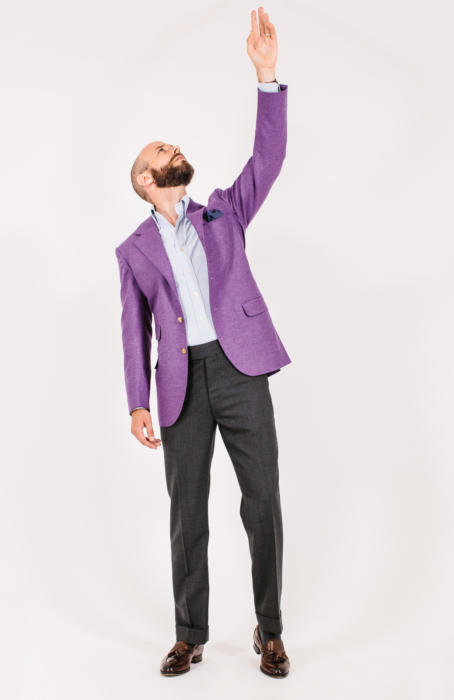
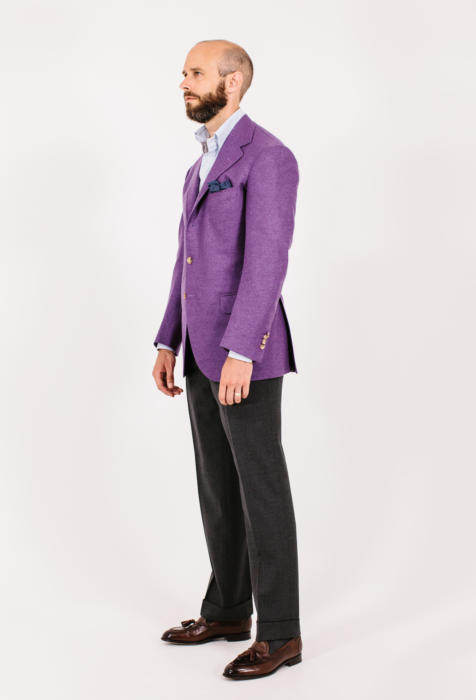
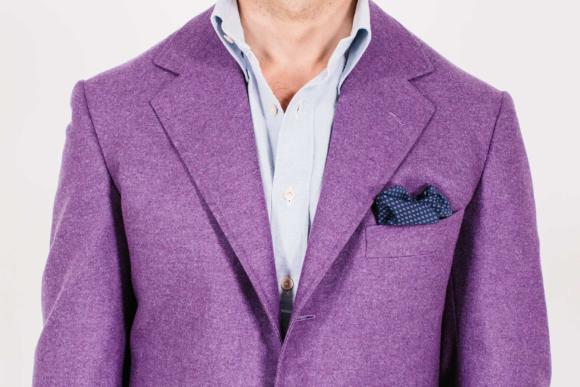
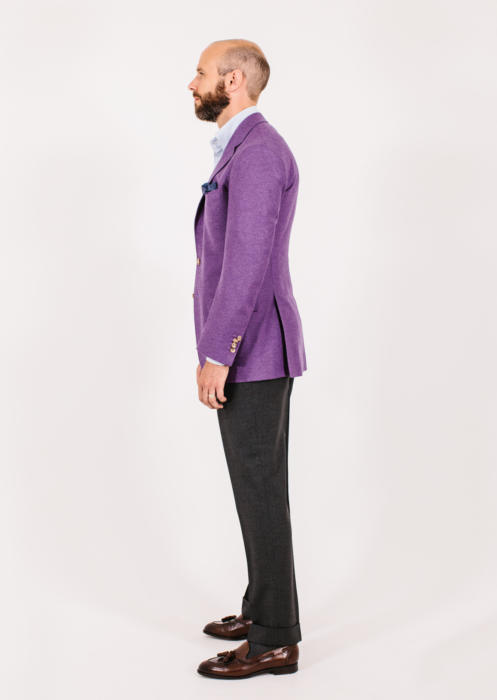
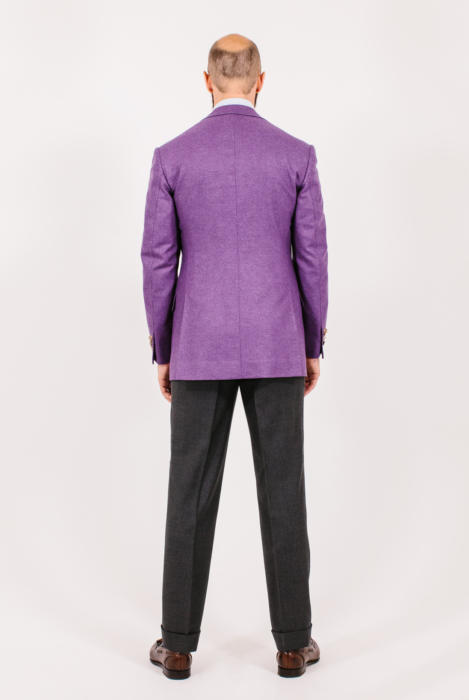
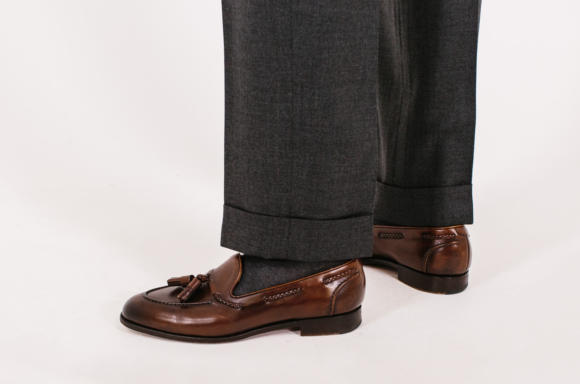


























Interesting article. Do you plan on doing one for Cifonelli in this series?
We have shot and prepared one on Cifonelli, yes, but it will appear next year. For the moment we are journeying from London down to Naples, doing examples of each regional style – we’ll fill in the gaps with the major tailors later. We’re also planning a book which will contain the fullest coverage of everyone
The Jacket is beautiful. The profile shot shows how well it fits you. Seems like a great choice for the holidays. I have 2 Liverano suits and love them. I have a sport coat and grey chalk stripe suit in the works. I too with with what Antonio recommended.
Why the rather uneven placement of the sleeve buttons as shown in the sideview?
They’re not uneven really – it’s just that the second and third have moved a little along the buttonhole and the top one has not, because that buttonhole is not open.
Like many tailors Liverano keeps the top buttonhole closed so it can be removed and a new one cut at the bottom if at any point you want to lengthen the sleeve (particularly if you pass it down to a new generation)
Few can create a more elegant and beautiful tailored garment than Sig. Liverano. Yes, it’s expensive, as pointed out; but there is little doubt that the “snob factor” is at play here and its high cost and exclusivity is the very thing that attracts many to luxury items like this. The Liverano house has managed to produce something that is not easily copied and his clients have happily accepted his monetary capitalization of his skills.
Is the jacket padded as you note or it there significant wadding at the end of the shoulders?
The Liverano experience is unique. Antonio picks out your fabric based on a skillful analysis of your “person”, measures you and tells you thank you and he’ll see you in a few months. His services are accompanied by no discussion about what buttons you want and the length of your jacket. He is very polite and pleasant, but the experience is quite different from many other houses.
Thanks Jackson. The shoulders have a thin pad with a little sleeve wadding in the sleeve head. But nothing significant.
We did discuss buttons and length, but with both I was happy with Antonio’s suggestions
Hahahaha….sure, Simon, whatever you say…Every Liverano client walks away saying that while he chose nothing directly, he was “very happy with Antonio’s suggestions.” And I do believe it’s the truth in all cases as Antonio is nothing short of brilliant. But think about it; he chose the fabric, the color, buttons and length, lapel width, and padding level. Any decision-making with Antonio is mere chimera; it is hoped for and, indeed, felt, but it doesn’t truly exist.
Simon
A buttonhole on a sleeve is either “working” or “sham”. “Open” or “closed” are not correct descriptions.
Thank you, but ‘sham’ would not mean anything to most readers, so I tend not to use industry terms like that
Sham is another word for false. I would imagine the majority of people know that.
Thanks, yes I’m sure they could. But closed or open is more descriptive and easier to understand I think
While i think the jacket is a thing of beauty, the fabric is incredible and the cut is sublime. At what point do prices simply become obscene? Regardless of ones affordability, I refuse to believe that Florentine rents and labour costs mean that a jacket/suit price is equal to what this jacket is priced at at the time of writing, along with the coat you commissioned a few months ago for an astronomical figure. I have read in past posts that you have defended the ever increasing price of bespoke tailoring, far outstripping inflation, wage and rental increases, but how can one justify Liverano’s pricing? I have been wearing almost exclusively bespoke tailoring for going on five years, and I’m happy to pay for craftsmanship and even a tailors historical depth to a minimal extent but I must say with L&L and quite a few other tailors whose prices have increased by 30+% in 2/3 years, it’s all gone a little mad…
I do apologise for going a little off the intended topic of evaluating the tailor and the garment itself, just venting!
I do agree James, it’s hard when comparing this to other tailors.
The only thing I can really say is that bespoke remains good value generally. The best example I have there is one well-known tailor that also makes for customers of a designer brand. The brand sells it for a 40% higher price than the tailor, and that does actually fit with the brand’s other pricing – given what it charges for RTW etc. So at least you’re not paying that.
Hi James, I feel your pain! However, I would add to Simon’s reply by saying that there are two other factors at work here. The first is demand – as the order book grows, grand tailors like Liverano often don’t expand like other businesses might, but rather use price increases to control order flow. Their staff are highly skilled and they sometimes feel that expanding would impact quality. The second is the artist factor – the ‘creative inspiration’ of the tailor rather than just the sum of the raw materials is reflected in the end price. Grand tailors (mostly correctly) believe that their input into the process has a value – Liverano might be compared with Rossetti, Rubens, Rothko, etc., depending on your taste! I agree that the tailoring inflation rate over the last few years has been rapid, but this has also been mirrored in other luxury handmade products like watches. Finally I would just add that in my experience customer loyalty is rewarded by many tailors – my current SR tailor gives me a discount on their standard prices based on my regular orders.
I’m 99.9% The Armoury’s involvement has something to do with it.
Especially considering the fact that the Armoury’s prices for L&L are significantly higher than what Simon published here for a 2 piece suit ($7200 vs €5730).
people who shop at armoury are people who need someone else to guide them how to dress, so that’s the price they pay.
Very interesting post, Simon. Although I’d never wear a colour like this, I have to say that it’s a beautiful jacket and it looks good on you.
I tend to prefer the straight cut to the lapels that many European tailors employ, as illustrated here, compared to the more rounded, belly lapels of UK tailoring. Are you aware of any British tailors that cut lapels in a similar way? Would it be a good idea to ask a UK tailor to cut lapels in this way or would you advise against it?
No I don’t to be honest. And it’s something I’d be nervous about asking them – it’s not easy to describe or define, and even if they could precisely copy what someone else had done, it might be a little insulting to ask them to change such an artistic part of the garment.
Thanks, Simon. I thought that would probably be the case.
Seems like a jacket that would certainly turn heads anywhere you go, Simon. Which begs the question, how would a peak lapel look on this jacket? And if one is feeling even more adventurous, why not make it a three-roll-two, with such a beautiful roll?
I can see the attraction of a peak, but if anything it’s nice to tone down everything else?
It is a three roll two, just a very high one!
Hi Simon,
Interesting article. I actually wanted to raise a couple of points about the trousers. I recall that you once advised that black shoes should be worn with charcoal grey trousers. Is that still your view ? The trousers you are wearing look close to charcoal ?Secondly ( I am having 2 pairs of bespoke trousers made ) have you ever considered wearing braces? I understand that this provides a more precise break across the shoes.
Thanks
Paul
I think its perfectly fine to wear chestnut brown or brown suede shoes with charcoal, be if flannel or worsted.
Hi Simon…..I take it you have been using Luxire further to your recent review, any notable points of interest, such as any improvement in hardwear?
They made one more pair of trousers, yes. They improved the fit and the hardware a little. I’d still say the points in the original review stand though
Do you find it hard to maintain the lapel roll? Other examples of the Liverano cut that I have seen tend to have flatter lapels after a while.
No actually, thats never been a problem. It is quite a thick cloth though
Sorry, but l thought the idea of bespoke was that it compensated for the wearer’s imperfections. This seems to emphasise them.
Please give examples if you can. That’s not very useful on its own
The shoulders. In my opinion it’s one of the worst I have seen in your jackets. They look really asymmetrical and I hate the divot at the top of the sleeveheads.
All a bit “Portillo’s European Railway Journeys” for me…
Simon, your pants especially in the last photo are at least a half inch short poss. 3/4 too short. You need a slight break .
Did you read the text Harry? I’m holding them up
Given the choice for dark trousers (and obviously shoes), are the buttons not too light? Darker buttons (grey, brown for a more casual look) would have provided sufficient contrast with the cloth and match the rest.
Yes, nice point Gonzague. I like the buttons a lot with the jacket in isolation, but farther ones would suit the other dark things more
I have a jacket in similar colour and cut though in cord. It is flamboyant and I am interested in the type of uses you put it to. Evening drinks events etc.? Some interesting points about value. Beautiful fabric aside the price is only good value if you want this particular (albeit precise) cut (and yet it doesn’t quite fit in the sleeve head – too tight). The lapel notch and line is visually high and the shoulders are fully emphasised (not unusual in Italian cuts) – the wider shoulders support this aesthetic. Ordinarily this would flatten and de-emphasise the chest but the utilisation of the very rolled lapel pushes the chest out and counter-balances this. The roll and high button point also lift attention away from the waist, which, if the jacket fronts were longer, would look too high and the length too long. I agree with another comment that use and cleaning/pressing may flatten the rolls over time. Italy being, perhaps, too far to go just for the house pressing style. You mention a single dart in the waist but with no illustration but we do have an image of you pointing to the ceiling. I think it also worth mentioning that readers might be interested in viewing some of the inner jacket work as it can often display levels of finishing (being as it is hidden). P.S. The sentence ‘That is reinforced’ doesn’t make sense (para four)?
I meant that the emphasis on the top of the body is increased by the cut of the lower half.
Thanks on the other points. Yes, it is mostly events, evening or just a nice lunch if open necked.
I appreciate there are lots of other things we could show in the jacket, but this is not intended to be a full review – going into every aspect would take several posts. This series is intended to give a full look at cut, style and measurements
Really great piece. The waist suppression, open quarters and slightly roped shoulders make up for the high buttoning point and lapel roll and minimizes their tendency to shrink the chest (e.g. your Caraceni). The cloth reflects light and holds shape beautifully, though is no doubt flashy (so I agree with the trouser pairing). The back is also beautifully proportioned.
It’s a small point but I may have gone for darker buttons and worn the jacket exclusively with black shoes.
Two questions:
First, can you explain what you mean by “square lapels”? Does it mean that the angle where the line of the lapel turns into the notch/gorge is close to 90 degrees?
Second, on a question of style, with a very unusual colour like this which would imply casualness, do you think having a relatively smart styling elsewhere (strong and square lapel, defined shoulder, flap pockets, nice finishings, etc.) balance out the unconventional/casual colour. I’m feeling the simplicity and sharpness of the rest of the styling is why the unusual colour works.
Or maybe you’ve just worn it with some good combinations. 🙂
Yes, that’s right.
On style, it’s probably more useful thinking of this as strong or showy, rather than casual. More like a bright waistcoat with morning dress, or bright socks with a suit, than a strongly coloured tweed jacket for instance
The Chittleborough & Morgan suit had a bit of a Batman vibe to it; here, the purple blazer recalls the Joker. Consider adding a green vest. 🙂
If you don’t mind would you name 3 occasions when you wore this jacket with and without tie?
This is what I’d wear were I ever invited to a hen party.
Is the liverano cut representative of the Florentine style? Do other Florentine tailors give a similar cut e.g Kotoro?
Kotoro combines different styles, but there are elements of it in there yes.
Florence has never had as distinctive a style as some other parts of Italy, and if anything Loris Vestrucci is closer to traditional Florentine cutting. But still, it wouldn’t be inaccurate to refer to this as Florentine style. Just be aware there are never perfect neat boxes for these things
Hi Simon, what about Shibumi in terms of styling? How florentine are they?
Not especially – as with many styles, from I can see I’d say a mix between Florentine and Neapolitan, but more the latter
Have you had any tailoring made by them? How would you rate them?
Thank you Hugh.
Actually my question went to Mr Crompton.
Sorry Don. Occasions include:
– Evening party (with tie), eg launch of new shoes at Gaziano & Girling
– Savile Row event during LCM (at Lord’s, with tie)
– Day working in the office, with lunch at nice restaurant with a contact/client (no tie)
Interesting how the shoulders really looks padded and somewhat British (to my non-British eyes) with such minimal padding. Perhaps the best of both worlds, you get the strong look of the British cut in the feel of the soft Italian cut?
Comparing this to the Liverano jackets of The Armoury crew, I can’t say their shoulders looks the same, but I’d assume Antonio only does the house cut?
Yes, pretty much.
Good point about the strong shoulder. Interesting how it looks like that despite not being that wide or that padded
Aside from the brave material choice, the cut is interesting. I’m struggling to find the right words to describe it, but this coat appears to emphasise the upper trapezius. Is the collar a bit higher than usual?
The effect (shoulder strongly sloping) is one I have noticed on a number of your coats (although not so much with eg the Richard Anderson), but it seems more pronounced here.
Simon do you always stand with your hands/arms so far forward? It looks very unnatural and must be a swine when it comes to getting the pitch right.
That’s just the natural pitch of my arms I’m afraid… Not much I can do about it
I need to be honest. The color of that jacket makes it largely unwearable for 99% of all occasions where jackets are appropriate. It’s transcending into peacock territory .
Honesty appreciated.
is a square/right angle at the shoulder recommended, whatever the shoulder slope?
Not sure l understand this question Gonzague.
G. Fischer’s point about being unwearable, though honest, reflects on the modern appreciation of style and what can be worn. The jacket isn’t the problem, the lack of situations wherein people can dress this way is. Tangentially, as Liverano are Florentine and, as such, with a presumably Florentine aesthetic do you think that the colour would be less flamboyant (read more wearable) in its native surrounding than in the greyer light of the UK?
Nice idea – I think only in the summer though, and then it would be too warm. Florence can feel a lot like England in the winter…
Please let us not forget that if it were not for Simon commissioning pieces like this, the website that we all enjoy reading, learning and buying from would become very boring. Shades of Navy and Charcoal Suits Shades of White and Blue Shirts and a few Sports Jackets
Of course he is aware that a purple jacket for £5000+ is a little ridiculous of course he probably doesn’t wear it every week or even once a month – given the size of his wardrobe but to keep this website and his wardrobe interesting why wouldn’t/shouldn’t he commission it and others like it, I think as adults we can do better than to comment negatively on something like this
Style is subjective after all.
This jacket is perfect for someone who has all the basic stuff and wants to continue the sartorial journey in a meaningful way, keeping in mind that business and many other places that used to be formal are now becoming more casual by the day. It’s also the perfect jacket for holiday and other cocktail parties, theatre dates, a Saturday luncheon or dinner date, a Sunday brunch, a child’s performance recital, a ballet performance, comedy club or other live entertainment show, a lecture series attendance, a concert, a book review talk, a Sunday afternoon stroll with the dearest, etc. It’s smart casual and there are many places for it.
Also, we should also temper our own market sensitivities with the acknowledgment that £5000 for one man is £300 to another and it’s no more “ridiculous” for some to purchase this exact jacket than it is for others to have more than a few pair of shoes or eating dinner out several times a week. So let’s suspense with the backhanded compliments.
My compliment wasn’t back handed, apologies to anyone and Simon that thought it was. I, for the most part Mr. Hart, actually agree with you.
Far too short in my opinion. It would not fit my body type
With respect Jackson your long list of events and the sartorial register therein may be idiosyncratic to geographic location and cultural milieu. Thus it may not translate into other realms. Oddly, despite the wealth here, Londoners generally tend to dress down rather than up (patrician modesty perhaps?).
‘Point taken, Anonymous. However, I lived in London for four years and Cambridge for two. While the aristocratic veneer of nobility affects those old fogeys left over from days past of dark smelly wood and fussy and strict social and dress codes, many of the younger and hipper have long ago rejected the bowlers and oxfords as a uniform of blue-bloodedness – black from head to foot – in favor of individual, yet classic styling. Paired correctly with toned-down items, there are plenty of places this beautiful and tasteful jacket works in New York, London as well as any culturally urban environment. ‘Give it a chance?
Beautiful trousers Simon!
Hi Simon, just wanted to ask, what’s your opinion on Milanese buttonholes? Do you request them on all of your jackets?
Best,
David
Hi David,
I think they’re lovely, and I would usually have them on a jacket from any tailor that offered them. Most don’t, however.
A well worked Milanese is a thing of beauty. Bit of a dying art though. Getting the silk is not getting any easier either. I think the increasing rarity makes them seem even more special.
Do you think it’s dying? There are English and Asian tailors offering them now that hasn’t even heard of it 10 years ago
I thought they were more mainstream than that, kind of a Pitti thing. And true I also saw a lot of them in Asia, including a very beautiful, neatly made one on a Korean friend’s jacket.
So, Simon, I can assume one shouldn’t look for a Milanese to assess the quality of a jacket? Do you usually ask your tailors if they offer them? Do your Neapolitan jackets have them?
No, it’s a nice touch but it’s only one aspect of the quality, and a pretty small one at that.
No, none of my Neapolitan jackets have it. You’re seeing it a lot more on ready-made and MTM garments though. Perhaps it will become the new version of working buttonholes – stolen from bespoke to trying and lift up RTW
A machine made Milanese?? How awful.
Of course you would never look for a Milanese to assess the quality of a jacket.
All a Milanese could ever do is give you a clue to the skill level of the finisher.
Working a proper Milanese takes skill and time.
I have a suede blazer of similar colour which my colleagues uncharitably call my Willy Wonka jacket. I wear mine with a white shirt channeling Nick Wooster (https://www.pinterest.co.uk/pin/160440805448177333/), and according to these photos, now you! I think it is great with a bashed up pair of once-smart indigo jeans and shoes.
That’s a beautiful purple. I see it matching well with a lighter colored trouser though such as white or light blue or a pinstripe mix of those two. However, I assume it is a heavier fabric and hence the white trouser might clash a bit as white is normally worn for warmer weather or summer months and darker colors are for colder or winter months. But then again it’s really up to who’s wearing it. I would pair it with white trousers. Looks great though.
Hi Simon, beautiful jacket. What are your thoughts on the line of RTW that Liverano is selling through the Armoury? Can one justify the price in order to get the Liverano style given the garments are hand made and finished?
I haven’t seen it in person so can’t really comment I’m afraid. Good to know what handmade means though. I assume it doesn’t have any of the hand padding etc of the bespoke
Thanks. Will double check. Quick question on the trousers as I am looking for a pair like this. I understand it is a 9/10oz crispaire, would you say this can be used 3/4 of the year?
Yes
Hi Simon,
This is by far the best piece I’ve seen so far on this website.
The color, the cut, the material … an absolute beauty!
Having said that, I wonder why did you choose that color for the trouser?
I know you probably wanted to tone it down, but that dark trouser really killed all the fun.
I am not in a position to advise you on anything related to style, but I would have chosen to wear it with a much lighter color ( a lighter tone of grey or even white during warm and sunny days).
That’s my honest opinion.
Anyway, that jacket is pure art. Lucky you!
Thanks. I quite like the way the dark-grey trouser supports the jacket and makes it more conservative. But you’re right, a mid-grey or cream would also be nice. The latter might be rather showy for me though
Hi Simon.
After 3 years of learning from PS and a few great bespoke experiences with English and Neapolitan tailors recommended by you I am now considering to spurge on a Liverano jacket. I currently use Thom Sweeney for formal suits and Solito for more casual jackets. I feel I have developed a great relationship with these tailors and love their styles but can’t help to feel that Liverano is a must try for someone who has fully entered into the sartorial journey. Given Liverano’s price point though, am I just trying to justify an extravagance? Would you recommend to try Liverano solely on the basis of experiencing the best Italian tailoring can offer?
Thank you
PS: just got my Dartmoor, again a great product, keep them coming
Thanks, really pleased you liked the Dartmoor.
I think the answer to your question might be yes. Don’t go to a tailor just because you think they’re the ultimate. The expectations are too high and you’re likely to be disappointed. I would say only go to Liverano because you particularly want the style and the fit, and don’t feel you can get that anywhere else.
Hi Simon,
I’m a bit confused about a suit’s “fullness of chest” (which I think simply means more space between a shirt and a suit) and it’s relation to a suit’s drape or its absence.
Am I right if I say that:
1. there can be the full chest without any drape and in such case it is achieved by modeling the chest with the stiff canvas and the result is roundness and cleaness without any wrinkles,
2. or the full chest can be achieved with much softer canvas and considerable amount of drape, when excessive fabric creates typical wrinkles below armholes?
Please, is this correct or did I get it all wrong? I apologize if this is a rudimentary question and if you have some explanation somewhere else, please redirect me.
Thank you very much.
J.
Hey John. You’re broadly right, though 1 is rare – most tailors that use structured canvas don’t build out much from the body. Most of the time, fullness of chest means drape, as per 2, except that there’s a full scale there from a little drape to a lot, and until you get to a lot, there isn’t much in the way of wrinkles. Just a little bit
those quarters opening are the most definable feature of this Florentine style. does it cause an issue as you see more of the shirt between button and trouser and also the tie might stick out a bit too?
I don’t find it creates an issue with the tie, no.
With the shirt showing, perhaps a tiny bit, but it’s minimal compared to the effect of where you wear your trouser height
I would really like to know more about the fabric. You said it is a “woolen with a twill”. What weight has it? Has it a specific name (like flannel etc.)?
Is it possible to get a similar fabric in a different color? Do you know one?
The problem is, it was a vintage piece so nothing is known about it except by the feel.
It’s obvious it’s a twill, and woollen, and there is some milling to the surface as a flannel would have.
I would guess it’s around 13oz from the feel as well.
But I can’t say more than that, and no I haven’t seen anything that similar I’m afraid.
Hello Simon,
Sheikh Ali here from Sartorial Dhaka. I was wondering how do you measure the gorge height and the out breast pocket height.
Gorge height is actually the tip of the lapel to the shoulder seam. Slightly misnamed there.
The outbreast pocket height is from the bottom of the welt of the pocket to the shoulder seam.
Does your Liverano jacket has similar drape as your english suits like Henry Poole? I ask because you described it as moderate drape above and the english suits as small drape.
I find this an interesting aspect because I think it is less noticeable than on other suits due to the overall cut.
Yes, the drape is similar
Quick question, but how do you measure the length of a jacket? Presumably buttoned up and down the center seam, but do you include the collar or not?
At 31.25 inches excluding the collar, most (neapolitan) RTW jackets would be in a long size; would you say you are exceptionally tall/have long arms?
I ask because I tried on Liveranos RTW (beautiful and very much captures the spirit of Liverano Bespoke), but they measured some 74-75 cm, or ~29.5 inches which seems right.
It’s the length in the back seam – from the bottom of the collar to the hem
I know that Liverano’s style is for high armholes but you mention that they keep catching you and could have been lower. Did Antonio cut the armholes too high for your body or would they always be cut this high?
And is it a major adjustment to lower the armholes slightly?
I think it’s his style to have them that high, but yes they could be lowered a little
Thanks Simon. Would you find it more difficult to raise any issues regarding fit with a tailor like Antonio Liverano, because he is seen as being at the pinnacle of his craft? What I am trying to say is, if another tailor had made a jacket where the armholes felt tight/too high, would you have felt more comfortable in raising it with them?
It wouldn’t have made any difference to me either way, but I can see how it might do with others yes
About liverano price,hello simon how do you think about liverano price thesedays its jacket is 6500euro(include fabric)
I as a customer if it was about 4000~Euros it is not cheap can afford it,but 6500euro for jacket seems too much ,do you think they deserve price like this ? Like high end british tailors
That’s an awful lot for a jacket, but I would say Liverano deserves to be a on par with most top British tailors, yes
Hello simon have you saw guida’s cloth? I think it’s not bad and planning to try it
I haven’t, no. Sorry
Hello simon did you see liverano mtm?
No, I haven’t seen it in detail or tried it I’m afraid
Simon, a question, and a technical one without much techincal knowledge, so apologies. You mention here the lenght of the shoulder seam – how important is this for a good fit? Most of my jackets have this at around 15cm, like yours, but some of yours, like this one here and the A&S linen are closer to 18cm. I understand that, on most modern jackets, this seam is straight, i.e. not leaning/sloping backwards, but on some, particularly older ones, it does go back quite a bit down the back, leading to an outcome of a longer seam. I understand that is the case here and with your blue linen A&S. You also address this in a post on the suitmaker for the Raoul Walenberg film. How important is the length of this seam? And is the importance relative to its straightness/sloping? Are pit seam-to-seam and back width more important and better indicators for a good fit? Thanks!
Yes, they probably are, the shoulder seam can vary a fair bit with style (an extended shoulder) and with type of make (the backwards slope).
Hi Simon, how common are flap pockets like you had here with Liverano? Much of what I’ve seen outside PS from his house seems to be patch or jetted. Liverano himself is outside my range unfortunately, but I’m about to commission some stuff with his alums who have exclusively shown jetted or patch, so just wondering if this is just a convention, or something tailors have strong opinions about doing or not. Frankly, given that flap pockets can become jetted by just tucking the flap in, is there ever any reason to specifically go for pure jetted?
Not really, no. I’d go for flapped if you were unsure at all, and no I haven’t had anyone say they wouldn’t like flapped
Great article, Manish! It’s one of your best, and I found it highly relatable.
I recently lost my bespoke virginity after a 20-year wait (I think he is the one), and here are my takeaways from the fabric selection process:
1. Pre-researching specific fabric bunches turned out to be futile. Not all tailors have access to the same fabric books. If you have a specific fabric/bunch in mind, it’s best to check with your tailor beforehand. When in doubt, ask.
2. The cloth selection process is drastically simplified when your tailor shares your sense of style. By providing a brief description of what I was looking for a few days before my appointment, my tailor pre-selected a handful of fabrics he thought would be most suitable. I ended up choosing from his suggestions for a couple of reasons. Firstly, he has a great sense of style, and secondly, even if it wasn’t exactly what I had in mind, I knew I had a solid foundation to work with. There’s a certain charm in embracing the unexpected and falling in love with something you didn’t completely choose yourself. He chose these for me, I’ve been reading PS for over a decade, I can handle it.
3. Controversial take, I’ve come to see the classic blue blazer as somewhat cliché post 2020. Ex. I wear my gun club check sport coat to work I get complements; I wear my plain mid-navy jacket and people are asking if I have an interview. “Whoa, what is that? an Armani suit or something?”
I still favour a navy blazer over Simons barney-inspired Liverano but increasingly not by much.